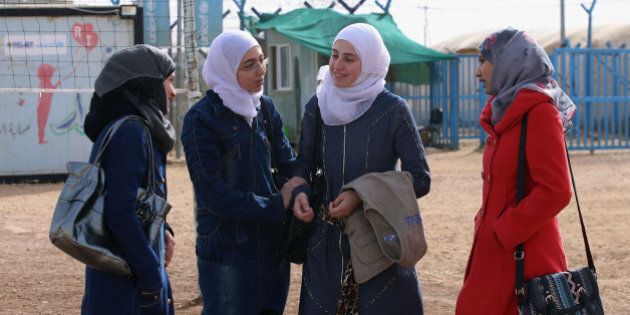
By Gillian Barth and Shaughn McArthur
This post is the fourth of a seven-part series on the themes of the High-Level Leaders' Roundtables at the first-ever World Humanitarian Summit, to be held May 23-24 in Istanbul, Turkey.
"We can do it!"
Generations later, this simple phrase remains inseparable from one of the most iconic images of the Second World War.
Set against a vivid yellow background, the arm of her blue coveralls pulled up to expose a flexed bicep, she wears short hair, a red bandana, and a look of determination upon her face. "Rosie the Riveter," as she is sometimes called, was originally conceived as a morale booster for women factory workers, at a time when they were being called upon to support the bustling home front war economy.
The impetus for changing gender roles remains one of necessity.
Through the decades, she has evolved into one of the most recognizable symbols of women's power and ability to fulfill roles once strictly reserved for men.
A similar dynamic -- in which war forces women from the home and into paid work, increasingly for their very survival -- is reproducing itself today, in protracted crisis situations around the world.
Women's changing roles
The impetus for changing gender roles remains one of necessity.
In Syria and its neighbouring countries, for example, the number of female-headed households continues to rise as men go to fight, are killed or go missing. Even when at home, men often cannot leave to work for fear of the authorities, so women are increasingly relied upon to take up paid work outside of the house.
Women are finding work with community-based organizations, as teachers, volunteering in improvised and clandestine health centres, and doing home-based work. They have also begun to meet the demand for first aid practitioners, search and rescue teams, and (para-) medical staff.
In agricultural production, Syrian women in 2015 constituted 65 per cent of the economically active population, an increase of six per cent compared to 2009. In some areas, women constitute up to 90 per cent of the agricultural labor force.
As one Syrian woman told CARE partners: "Women [in Syria] now know they can do anything -- but they learned this lesson the hardest way possible."
Changing gender dynamics
Shifting changing gender dynamics, in any society, are fraught.
According to Women, Work and War -- a research study recently conducted by CARE and partners in Lebanon, Jordan, and Turkey -- Syrian women and men feel that their roles and responsibilities have been essentially reversed: as she assumes increasing responsibilities outside the house and in managing the household budget, he loses his role as breadwinner and decision-maker.
But the exchange of roles is often incomplete, as women continue to shoulder the majority of household chores. Men are often reluctant to embrace new responsibilities within the home and feel emasculated, which has fuelled increasing domestic violence.
The conflict in Syria, while devastating, has opened a window of opportunity for women seeking an expanded role in their families and communities.
For others, taking on new responsibilities has meant resorting to degrading, harmful or dangerous means of supporting their families' livelihoods. This can involve smuggling essential goods, such as medical supplies and tools, into besieged areas. Others are forced to "wear men's outfits and go to fight on the front lines."
Young girls are being forced into marriage, either, in their families' eyes, for their own protection, or to take care of older, injured men. Some engage in survival sex. "Girls are sometimes forced to beg or to resort to selling their 'honour' in order to earn their living and help their families," said one woman in a besieged Syrian village.
An opportunity, and a choice
The conflict in Syria, while devastating, has opened a window of opportunity for women seeking an expanded role in their families and communities. The same is true in Yemen, South Sudan, Pakistan, Iraq, and in protracted crises around the world.
Social upheaval caused by conflict pushes women to discover strengths and capacities within themselves, acquire new degrees of self-consciousness and skills, gain decision-making power within the household and achieve visibility in their communities. But more must be done to promote women's capacity to contribute to the relief, resilience and recovery of their communities, and to counter the negative coping strategies and social repercussions that can accompany women's increasing agency.
On May 23-24, international leaders will gather in Turkey for the first-ever World Humanitarian Summit. United Nations Secretary General Ban Ki-moon has challenged world leaders to use the occasion to fundamentally reshape the humanitarian system. Canada must seize this opportunity to show that investing in those living and working in humanitarian situations around the world is not only the best way to assist people most in need, but also in the interest of the international community itself.
This should include commitments to new policies and programs that help women and girls participate in the economy and other public spheres. Displaced women and girls need access to work permits and opportunities, education, medical treatment, not to mention guarantees for their safety and rights within the host countries into which they have been forced.
Humanitarian assistance should recognize and build upon the work of women-led civil society organizations, which are already shaping the social, cultural and political fabric upon a post-crisis Syria will depend. Canada can support these aspirations through commitments to empower local women's groups, to engage men and boys as agents of change, and to collect and leverage gender, age and diversity dis-aggregated data towards more effective gender-responsive programming.
As human needs around the world continue to defy the humanitarian system's capacity to respond, women and girls' position within that system must be strengthened to promote stronger and more self-sufficient communities.
"Women feel strong, they see that they 'can do it,'" said Nuha, the female head of a household now living in Irbid, Jordan, echoing the words of Rosie the Riveter some seven decades ago. "Even men say 'Now the men are women, and the women are men.'"
Women know they have the power to bring change; it is up to the international community to respond.
Gillian Barth is President and CEO at CARE Canada, where Shaughn McArthur is Advocacy and Government Relations Advisor.
This blog series on the World Humanitarian Summit was convened by the Canadian Council for International Co-operation. The views expressed in each blog are those of the authors, and do not necessarily reflect the positions of CCIC, its members, or other participating organizations.
Follow HuffPost Canada Blogs on Facebook
ALSO ON HUFFPOST:
